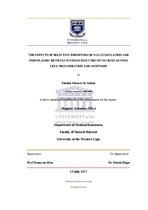| dc.contributor.advisor | Hiss, Donavon | |
| dc.contributor.author | Eshiak, Ebtehal Elkamel M. | |
| dc.date.accessioned | 2018-07-24T09:18:09Z | |
| dc.date.available | 2018-08-31T22:10:06Z | |
| dc.date.issued | 2017 | |
| dc.identifier.uri | http://hdl.handle.net/11394/6105 | |
| dc.description | Magister Scientiae - MSc (Medical BioSciences) | |
| dc.description.abstract | Among all childhood cancers diagnosed, neuroblastoma (NB) is the most prevalent during
infancy. In patients younger than 15 years, it accounts for more than 7% of malignancies and
about 15% of all paediatric mortalities. A family history of NB is considered a genetic
predisposition and risk factor. In 1-2% of inherited cases, the molecular causative factors
linked to the disease are germline mutations, including anaplastic lymphoma kinase (ALK, gain
of function), PHOX2B (loss of function) and MYCN (gain of function). NB differs from most
solid tumours because of its heterogeneity in both pathobiologic and clinical behaviour,
ranging from spontaneous regression to highly-aggressive metastatic disease resistant to
conventional and investigational anticancer drugs. Hence, NB embodies a spectrum of disease. | |
| dc.language.iso | en | |
| dc.publisher | University of the Western Cape | |
| dc.title | The effects of selective inhibitors of N-Glycosylation and Endoplasmic Reticulum stress inducers on Neuroblastoma cell proliferation and Apoptosis | |
| dc.rights.holder | University of the Western Cape | |

